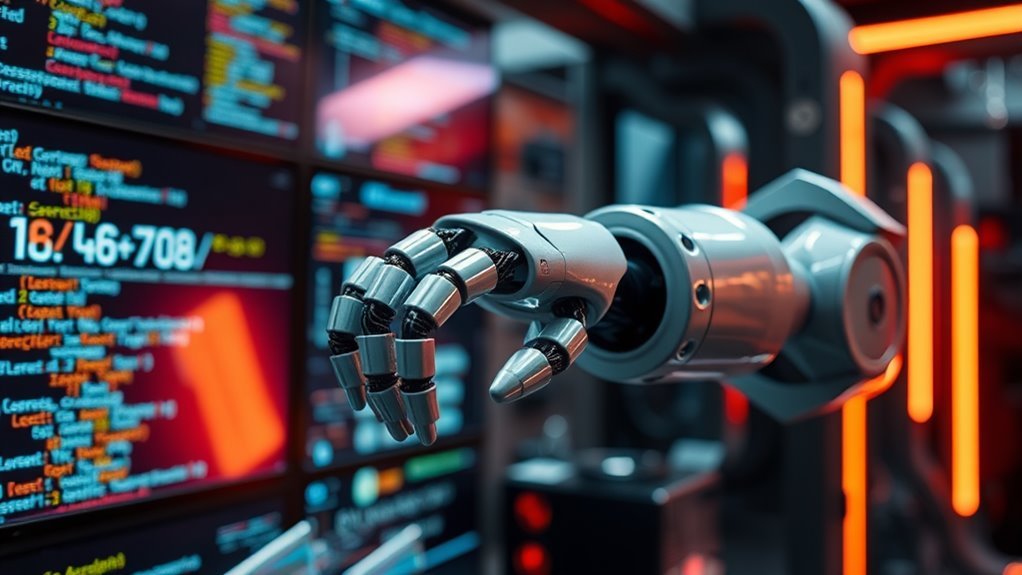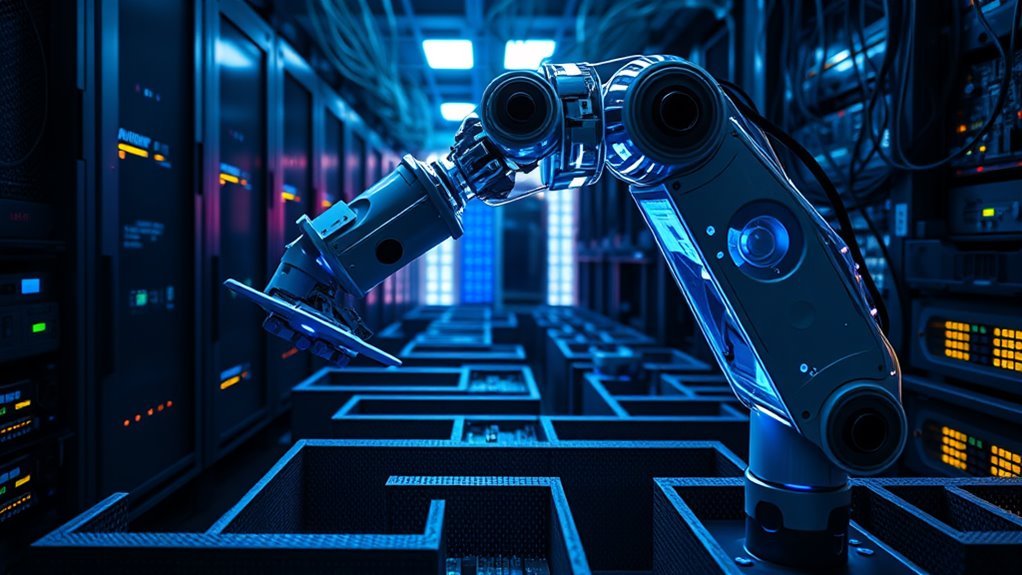You're stepping into the world of reinforcement learning, where agents learn from trial and error, and q-learning is just the beginning. You'll uncover how q-learning lays the groundwork for more complex deep reinforcement learning techniques. As you progress, you'll investigate deep Q-networks, agent architecture, and training processes. You'll learn how to optimize your agent's performance, and now you're poised to reveal the intricacies of deep RL, where your agent's journey is about to get a whole lot more interesting.
Need-to-Knows
- Q-Learning is a model-free algorithm for learning action values.
- Deep RL combines Q-Learning with deep learning models.
- Deep Q-Networks handle high-dimensional state spaces.
- Experience replay stabilizes training and improves efficiency.
- Neural networks approximate Q-values in Deep RL agents.
Q-Learning Fundamentals
As you investigate Q-learning, it's clear that this model-free reinforcement learning algorithm is all about learning the value of actions in given states.
You'll find that Q-learning uses a Q-value table to store the expected future rewards for each action in a state. The Q-value is updated based on the rewards received and the maximum predicted future rewards from the next state.
You need to balance exploration and exploitation to get the most out of Q-learning. Exploration involves trying new actions, while exploitation means choosing actions that yield high rewards. An epsilon-greedy strategy can help you manage this balance.
Q-learning is effective in environments with discrete action spaces, and it's influenced by parameters like the learning rate and discount factor. As you work with Q-learning, you'll see that it can help you learn ideal policies in various reinforcement learning scenarios, making it a fundamental component of your agent's journey in RL.
Deep RL Basics
You're building on the fundamentals of Q-learning, and now you'll integrate deep learning into your reinforcement learning toolkit. This integration is known as Deep Reinforcement Learning (Deep RL), which combines reinforcement learning with deep learning to approximate Q-values using neural networks.
The Deep Q-Network (DQN) is a notable example of Deep RL, where it successfully learned to play Atari games directly from pixel inputs.
In Deep RL, you'll utilize techniques like experience replay to store agent experiences, enabling the model to learn from past interactions and improve stability during training.
You'll likewise implement an epsilon-greedy policy to balance exploration and exploitation. By using neural networks to approximate Q-values, you can handle complex state spaces and improve the agent's decision-making capabilities.
Deep RL's effectiveness in various domains, including game playing and robotics, demonstrates its versatility and potential for complex decision-making tasks.
Agent Architecture

Designing the agent architecture is vital for effective Deep Q-Learning, and it typically involves creating a neural network that can approximate Q-values. You'll need to define the architecture, which usually consists of multiple Dense layers to capture the complex relationships between states and actions. This allows the model to learn effective Q-values. A common configuration includes an input layer that receives state variables, hidden layers for processing, and an output layer that corresponds to possible actions.
You can use Keras to facilitate the quick setup of the neural network architecture. When designing the agent architecture, you'll initialize parameters including state size, action size, and memory. These are fundamental for storing past experiences and enabling the learning process.
The agent's neural network will process the state and output Q-values for each possible action. By using deep learning techniques, you can create a robust agent architecture that can handle complex environments. Your goal is to create an agent that can learn to predict Q-values accurately, which is vital for making knowledgeable choices and taking ideal actions in a given state.
Training Process
One key aspect of a reinforcement learning agent's development is the training process, which involves repeatedly interacting with the environment.
You'll be using Deep Q Learning to train your agent, where it learns to balance the pole on the cart by evaluating its state and adjusting actions to maximize cumulative rewards. The agent interacts with the environment, observing the current state, selecting an action based on its policy, and receiving feedback in the form of rewards or penalties.
As you train your agent, consider the following key points:
- Update Q-values: based on observed outcomes
- Employ experience replay: to break correlation between samples
- Use a neural network: to approximate Q-values
- Optimize the model: using the Keras fit() method to minimize differences between predicted and actual target Q-values.
Memory Management

The agent's ability to learn from its experiences relies heavily on effective memory management, which involves maintaining a replay memory where experience tuples – state, action, reward, and next state – are stored.
You'll use this replay memory to facilitate the learning process in deep reinforcement learning. A typical sample batch size for experience replay is set to 32, allowing you to learn from a diverse set of past experiences.
You must prioritize which experiences to retain in the replay memory and develop strategies for sampling from it. The size of the experience replay memory is vital, as a larger memory allows for better generalization and prevents overfitting.
Regularly updating the experience replay memory guarantees that your training reflects a balance of exploration and exploitation over time. Effective memory management is essential for a successful learning process, enabling you to make the most of experience replay in deep reinforcement learning.
Action Selection
You're faced with a significant decision in reinforcement learning: action selection, which is primarily guided by the exploration-exploitation trade-off. This trade-off requires you to balance exploring new actions and exploiting known rewarding actions to maximize the expected reward. The epsilon-greedy policy is a popular approach, where you choose a random action with probability epsilon and the best-known action with probability (1 – epsilon).
To make knowledgeable choices, consider the following key aspects:
- Exploration rate: gradually decrease epsilon to favor exploitation over time
- Q-value estimation: use the DQN algorithm to predict Q-values for each action
- Action identification: employ the np.argmax) function to select the action with the highest predicted Q-value
- Reward accumulation: focus on maximizing cumulative rewards by making ideal action selections
Effective action selection is vital for achieving high cumulative rewards, and it's important to fine-tune the epsilon-greedy policy and other hyperparameters to suit your specific reinforcement learning task.
Learning Dynamics

Several key components drive learning dynamics in reinforcement learning, and they're all interconnected – as you adapt your actions based on rewards received from the environment, it guides your future decision-making. You'll navigate the investigation-exploitation trade-off, where you initially investigate random actions before exploiting learned knowledge to maximize rewards.
| Concept | Description |
|---|---|
| Q-Learning | Updates action values based on rewards |
| Experience Replay | Buffers past experiences for sampling |
| Discount Factor | Determines importance of future rewards |
| Exploration-Exploitation | Balances uncovering new actions and exploiting known ones |
| Learning Rate | Influences speed of knowledge updates |
You'll use experience replay to retain past experiences, allowing you to sample and learn from various situations. The discount factor will influence how you prioritize immediate versus long-term rewards. As you master learning dynamics, you'll improve your Q-Learning approach, making you a more efficient agent.
Neural Network Optimization
Mastering learning dynamics is just the beginning – now it's time to optimize your neural network. You'll need to adjust hyperparameters like the learning rate to improve model performance and convergence speed.
Neural network optimization is essential for achieving stability and preventing overfitting.
To optimize your neural network, consider the following:
- Tuning the learning rate for better convergence
- Implementing experience replay to break correlations between experiences
- Selecting appropriate activation functions like ReLU or tanh
- Using regularization techniques to prevent overfitting and guarantee stability.
Most-Asked Questions FAQ
What Is the Ideal Batch Size?
You're determining the best batch size, balancing training stability, performance enhancement, and memory efficiency for faster convergence speed, while considering data diversity to achieve optimal results.
Can Agents Learn From Humans?
You're exploring if agents can learn from humans, leveraging human feedback, imitation learning, and active learning in collaborative environments with reward shaping and transfer learning.
How to Handle Partial Observability?
You handle partial observability by tracking hidden states, using belief states, recurrent networks, attention mechanisms, environment modeling, and accounting for observation noise to reach well-reasoned conclusions.
What Is the Role of Entropy?
You're exploring entropy's role, balancing exploration trade off, and seeing entropy regularization benefits, which impacts policy, convergence, and action, while reducing uncertainty.
Is Pretraining Always Necessary?
You consider pretraining benefits, drawbacks, and investigate alternatives like transfer learning, domain adaptation, for data efficiency and training stability, realizing it's not always necessary.
Conclusion
You've guided your agent from Q-learning to deep RL, designing its architecture and training process. You've managed its memory, selected actions, and optimized its neural network. Now, your agent's journey is complete, and it's ready to tackle complex tasks, learning and adapting in dynamic environments, with you overseeing its continued growth and improvement.
